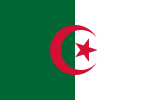Algerian wine
| Part of a series on the |
| Culture of Algeria |
|---|
 |
| People |
|
Mythology |
|
Art |


Algerian wine is
Algeria has a long history of wine production dating back to the Roman era. During the late 19th century, Algeria's wine production peaked and it became the largest wine-producing country in the world, with an annual production of over 3 billion liters of wine. At the time, Algeria was a French colony and much of the wine produced in Algeria was exported to France to be used for blending with French wines.[2][3]
Most Algerian wine production takes place in the regions of Mascara, Mostaganem, and Tiaret, which are located in the northwest of the country. The most commonly grown grape varieties in Algeria include Carignan, Grenache, Cinsault, and Alicante Bouschet, which are used to produce both red and rosé wines.[4]
Algerian wines are known for their deep color, rich aroma, and full-bodied flavor. The climate and soil in Algeria are well-suited for grape cultivation, with warm, sunny summers and mild winters. In 2019, Algeria produced approximately 500,000 hectoliters of wine, making it one of the largest wine-producing countries in Africa. Most of this wine is exported to other countries, including France, Italy, and Spain, where it is used for blending and sold under other labels.[5]
With as much land under vineyards as the countries of Germany and South Africa, Algeria continues to maintain a wine industry with over 70 wineries in operation.
Despite the challenges facing the Algerian wine industry, there is a growing interest in producing higher quality wines and promoting Algerian wine as a unique and distinct product. Some producers are experimenting with new grape varieties and modern winemaking techniques, while others are focusing on marketing their wines to a domestic audience. As a result, there may be potential for growth and innovation in Algerian wine production in the future.[6]
History
The roots of Algerian
The high point of the Algerian wine industry came in the late 1930s when over 4,000 square kilometres (1,500 sq mi) was producing more 2,100 megalitres (550,000,000 US gal) of wine. By the 1950s, together with Tunisia and Morocco, Algerian wine accounted for nearly two thirds of the wine that was internationally traded. To a large extent, Algerian red wine was used for blending with red wine from the south of France, since Algerian wine was deeper in colour and higher in alcohol than the French wines produced from Aramon grapes.[6] The dominant grape variety in Algeria at this time was Carignan, which only overtook Aramon in southern France in the 1960s.[8]
By the time of Algerian independence in 1962, over a dozen areas were granted
Climate and wine regions
All of Algeria's vineyards are located in the
- Coteaux de Tlemcen
- Monts du Tessalah
- Coteaux de Mascara
- Dahra hills
- Coteaux du Zaccar
- Médéa
- Aïn Bessem Bouira
Grapes and wine
During the peak of Algerian wine production, the main grapes of the region was
See also
References
- S2CID 232395699.
- ^ Finn, Katie (2020-11-17). "Vine Social: A Look Back at the Time When the World's Largest Producer of Wine Was … Algeria?". Coachella Valley Independent. Retrieved 2023-02-25.
- S2CID 232395699.
- ^ "Food and Agriculture Organization of the United Nations: "Algeria"". www.fao.org. Retrieved 2023-02-25.
- ^ "International Organisation of Vine and Wine (OIV) Statistical Report on World Vitiviniculture 2020". www.oiv.int. p. 32. Retrieved 2023-02-25.
- ^ ISBN 0-19-860990-6.
- S2CID 247210955.
- ISBN 0-19-860990-6.
